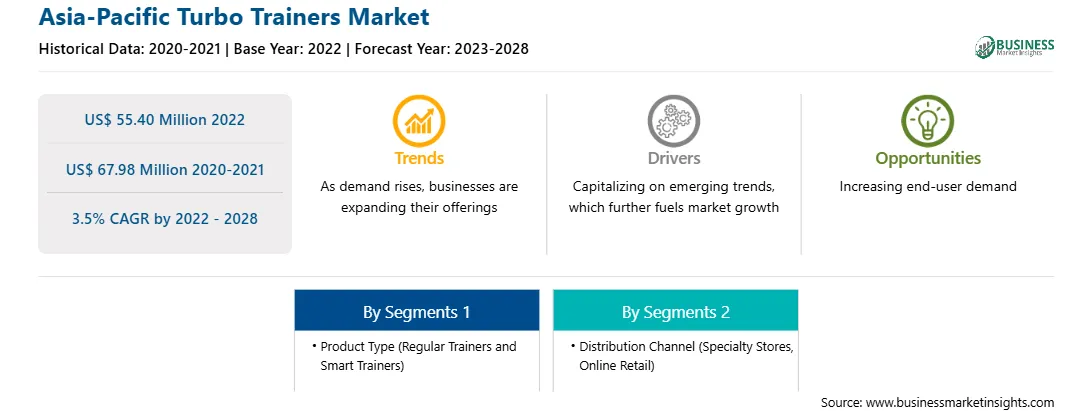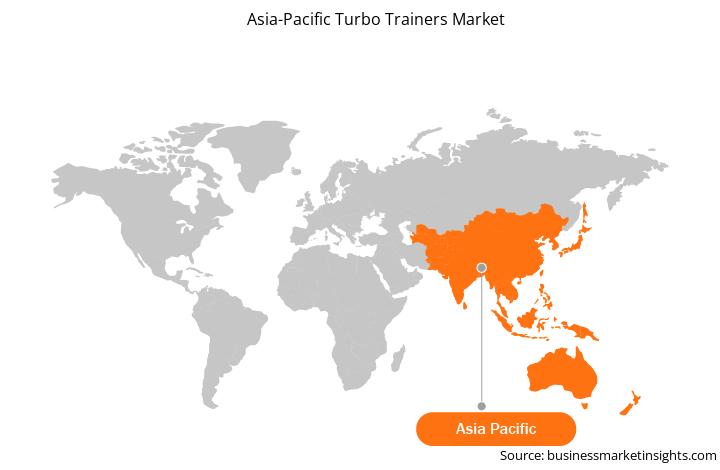Suppliers in the market are collaborating with specialty stores to meet their requirements by providing customized solutions. Moreover, product innovations by these companies, along with other strategic moves, are attracting consumers to choose from a wide range of products. For instance, in August 2020, Wahoo announced the launch of a newly developed turbo trainer with improved automatic calibration abilities and accuracy. Also, Wahoo Fitness launched KICKR Smart Trainer and KICKR BIKE. Both devices are designed with enhanced features, including Wi-Fi connectivity, which enables a more seamless and connected user experience across the Wahoo ecosystem in September 2022. Similarly, in April 2020, Cyclist, in collaboration with Tacx, announced the launch of a new gravel riding turbo trainer for individuals who are unable to venture out to cycle during the ongoing COVID-19 pandemic. Further, in September 2022, Saris announced the H4 smart, direct drive trainer that features a flywheel; a cassette from SPRAM and Shimano; protocol compatibility of ANT+ FE-C and ANT+ Power; and Bluetooth Smart Trainer Control and Bluetooth Smart Power. Hence, the growing technological advancement in turbo trainers is expected to drive the market in coming years.
The emerging countries in APAC, such as China, Japan, and India, are witnessing an upsurge in demand for home fitness equipment, which offers many opportunities for the key players in the turbo trainers market. Rapid urbanization, rising disposable income, and a surge in youth population and their need to stay fit, including managing overall weight and body aesthetics, are contributing to the market growth. Moreover, the growing trend of smart turbo trainers, which allow millennials to connect to each other people via cycling apps such as Zwift while exercising from their homes, is also proliferating the market growth in the region. Moreover, cycling may be a mitigating factor of various disorders, such as heart diseases. The rising prevalence of medical concerns related to muscles, ligaments, and bones in individuals is increasing the demand for turbo trainers, as regular exercise can reduce the risk of bone strength losses in older people. According to the National Library of Medicine, in APAC, CVD accounts for less than 20% of all deaths in countries such as Thailand, the Philippines, and Indonesia and 20-30% in urban China, Hong Kong, Japan, South Korea, and Malaysia. Countries such as New Zealand, Australia, and Singapore have a relatively high death rate that exceeds ~30-35%. Therefore, the upsurge in the prevalence of diabetes, CVD, high blood pressure, and other chronic diseases is a major factor contributing to the market growth in the region.
Strategic insights for the Asia-Pacific Turbo Trainers provides data-driven analysis of the industry landscape, including current trends, key players, and regional nuances. These insights offer actionable recommendations, enabling readers to differentiate themselves from competitors by identifying untapped segments or developing unique value propositions. Leveraging data analytics, these insights help industry players anticipate the market shifts, whether investors, manufacturers, or other stakeholders. A future-oriented perspective is essential, helping stakeholders anticipate market shifts and position themselves for long-term success in this dynamic region. Ultimately, effective strategic insights empower readers to make informed decisions that drive profitability and achieve their business objectives within the market.

| Report Attribute | Details |
|---|---|
| Market size in 2022 | US$ 55.40 Million |
| Market Size by 2028 | US$ 67.98 Million |
| Global CAGR (2022 - 2028) | 3.5% |
| Historical Data | 2020-2021 |
| Forecast period | 2023-2028 |
| Segments Covered |
By Product Type
|
| Regions and Countries Covered | Asia-Pacific
|
| Market leaders and key company profiles |
The geographic scope of the Asia-Pacific Turbo Trainers refers to the specific areas in which a business operates and competes. Understanding local distinctions, such as diverse consumer preferences (e.g., demand for specific plug types or battery backup durations), varying economic conditions, and regulatory environments, is crucial for tailoring strategies to specific markets. Businesses can expand their reach by identifying underserved areas or adapting their offerings to meet local demands. A clear market focus allows for more effective resource allocation, targeted marketing campaigns, and better positioning against local competitors, ultimately driving growth in those targeted areas.

The APAC turbo trainers market is segmented based on product type, distribution channel, and country.
Elite; Garmin Ltd.; Jetblack Cycling; Kurt Manufacturing; Minoura Co. Ltd.; Nautilus, Inc.; Saris; Technogym SpA; Wahoo Fitness; and Wattbike Ltd. are the leading companies operating in the APAC turbo trainers market.
The Asia-Pacific Turbo Trainers Market is valued at US$ 55.40 Million in 2022, it is projected to reach US$ 67.98 Million by 2028.
As per our report Asia-Pacific Turbo Trainers Market, the market size is valued at US$ 55.40 Million in 2022, projecting it to reach US$ 67.98 Million by 2028. This translates to a CAGR of approximately 3.5% during the forecast period.
The Asia-Pacific Turbo Trainers Market report typically cover these key segments-
The historic period, base year, and forecast period can vary slightly depending on the specific market research report. However, for the Asia-Pacific Turbo Trainers Market report:
The Asia-Pacific Turbo Trainers Market is populated by several key players, each contributing to its growth and innovation. Some of the major players include:
The Asia-Pacific Turbo Trainers Market report is valuable for diverse stakeholders, including:
Essentially, anyone involved in or considering involvement in the Asia-Pacific Turbo Trainers Market value chain can benefit from the information contained in a comprehensive market report.